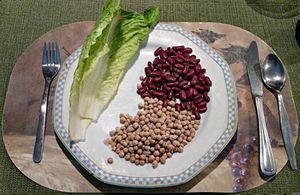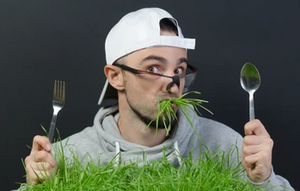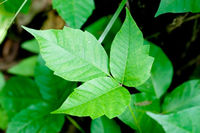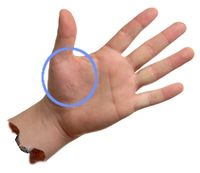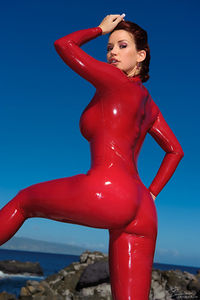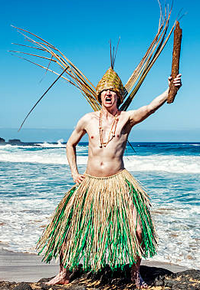HowTo:Be Vegan
“Anyone who eats so much as a grasshopper is eating God”
– Valentine Michael Smith on eating animals[1]
“Yum!”
– John the Baptist on grasshoppers[2]
“Ugh!”
– King Herod on John the Baptist[3]
“When I make wine it's always vegan”
– Jesus on wine
Thank you so much for reading this article on How to Be Vegan! I thank you, the United Nations thanks you, the animals thank you, and the planet thanks you! The plants, um, no comment. Veganism is just so important, it's just vital that more people learn what it really is![4]
We hope you're considering making the change to GO VEJ!
But perhaps you've heard that it's a difficult thing to do. Maybe you're afraid that you won't be able to do it right, or you'll mess it up and die of malnutrition, or you'll have to give up too much, that your life will get all weird if you try to GO VEGE. Well, never fear -- going vegan is easy, and this page will help you understand just how easy it really can be!
What is Veganism?[edit | edit source]
Being a vegan is far more than just not eating (or beating) meat. It means avoiding all animal products, in your food, in your clothing, and in your life. Treating animals as things to be used is wrong, it is sinful, it is evil, and it must be avoided completely if you are to call yourself a Vegan!
In fact, since animals are people too[5], it is extremely hypocritical for anyone who calls him or her self a human to not be Vegan! So, in short, being Vegan just means being an honest human being! If you're not vegan, I really don't understand how you can even face your reflection in the mirror each morning!
But really, don't let any of this scare you -- becoming an honest human by turning Vegan is easy. Ever since the Industrial Revolution, there have been good, inexpensive, effective, and fun alternatives to every animal product we use! On the remainder of this page, we'll tell you about things to avoid, and things which you should eat and use, if you are to be a good Vegan.
What is an Animal?[edit | edit source]
Before we discuss which products come from animals and which don't, however, we need to understand what it means to be an animal.
You may have have heard that "animals" are hard to define. Maybe you've been told that Euglenas are green, like plants, but swim, like animals, and so can't be categorized, and maybe you're concerned that this means you just can't know for sure if something's an animal or not. And in that case, how can you even know if you're eating an animal?
Well you can relax. Generations of vegans have worked this out, and the answer is a single, simple rule:
If it moves, or it eats animals, then it's an animal. If it doesn't move, and it doesn't eat animals, then it's not an animal.
Some Things which are Not Animals[edit | edit source]
- Poison ivy
- Distilled water
- Rocks
- Petroleum
- cyanide
- bong water
- grass
Some Things which Are Animals[edit | edit source]

- Dogs
- Amoebas (they move)
- All parasites of humans or other animals (they eat animals, or the flesh or blood of animals)
- Bugs (including grasshoppers and flies)
- Slime molds (they move)
- Venus fly traps (they eat bugs, which are animals)
And now that we've determined what things are animals, let's consider what you can and can't do in your new Vegan lifestyle.
Legal Pitfalls[edit | edit source]
Before we go on, however, we need to mention a legal issue which has arisen in the last few years, which makes it just a little harder to tell if you are in danger of eating an animal.
Unfortunately for Vegans, in the United States, a food grade substance which is included in a packaged product primarily to improve mouth feel, and which doesn't exceed 5% of the product by weight, does not need to be listed on the label.[6] Such hidden ingredients are referred to in the food preparation industry as loophole ingredients.
All nut and seed butters (including, in particular, peanut butter, tahini, and hummus) tend to separate and are somewhat runny and tasteless in their natural form. They can be improved a great deal by adding just a little of a solid fat to them as a so-called texturizer, and that's exactly what the manufacturers do. And, naturally, they use the cheapest fat they can find, which is lard.[7] In fact, all packaged nut and seed butters sold in the United States contain lard, and consequently cannot be eaten by Vegans!
But we will see later that there are lots of good, delicious alternatives to things like peanut butter.
Getting Sufficient Protein[edit | edit source]
The first thing most people think when they're told so-and-so is becoming a Vegan is, "OMG vegatables don't contain any protein! She'll get kwashiorkor -- I have to talk her out of this!!"
But it's not true -- in fact there are lots of very high protein vegetables, and good alternatives to all the high protein animal foods, as we will soon see!
Here are some high-protein animal foods you may encounter, particularly if you eat out a lot, along with their (much better) Vegan counterparts. In fact, many animal-based foods, like fried liver and onions, are things you probably wouldn't be ordering anyway.
So you can be sure you know exactly what it is that's to be avoided, we've provided moderately detailed descriptions for some of the less well known items.
- Peking duck -- The centerpiece at many Chinese restaurants, this is a whole roasted duck, cooked at high heat so that the skin turns a uniform golden brown and the fat beneath the skin just begins to melt. Brought to your table intact, it is carved by the chef, while you watch, just before you eat it. You, the customer, then select the most succulent strips of meat and, using the provided chopsticks, you arrange them on a thin, wide 'pancake', add some pieces of the crunchy skin with the melts-in-your-mouth fat attached, dab a bit of hoisin sauce on top using artistically cut segments of scallions, and then, after placing the scallions on top, you roll the whole thing up in the pancake and eat it. If the restaurant knows you've never had Peking duck before, they will provide a "catcher" for you, in case you swoon from the excess of sheer gustatory ecstasy which will accompany your first experience of such a dish.
Since a duck is an animal, you, as a Vegan, must not eat this. You can watch your friends eat it, but you'll be saying "Just the water, thank you!".
Vegan alternative to Peking Duck: Beans.
- Fried chicken -- We don't mean the limp, greasy rot-gut you get from certain fast food restaurants (you know the ones). We mean the good stuff, the Ambrosia of the dinner table, that's made from real chopped up birds and not from pulverized homogenized bird particles mixed with lard and a "binder" (whatever that might be).
To properly prepare fried chicken, you need something with a thermostat. A good electric frying pan will do. Put about an inch and a half of high quality oil in it. (Canola is good, coconut oil is good; lard is the best. Olive oil is expensive and can't take the heat so don't use it.) Heat it to about 425 F. While it's heating, prepare the chicken.
Cut it into appropriate sized pieces. In fact, you'll never find anything better than fried thighs and drumsticks, so you might as well just use them -- either buy them separately or use the rest of the bird(s) for stewing or soup.
Now the important thing is to leave the skin on. Don't believe the wimps who tell you it's bad for you; it's not, and it's where most of the flavor is.
Rinse each piece, then roll it in lemon juice, then finally roll it in a mix of flour, salt, and a little black pepper. Put all on a plate to dry for a few minutes, and then plunge into the fat, which should be hot by now.
Cook for about eleven minutes, using tongs to turn it from time to time. When it's a nice medium brown, remove from the pan and place on paper towels to drain for a few minutes before serving. Try the first piece out of the pan to be sure it's done (carefully -- it's hot).
The oil can be saved for re-use if you strain out the particles of cooked flour.
Of course, you, as a Vegan, won't be eating any of this.
Vegan alternative to fried chicken: Beans.
- Eel -- An eel is a sort of fish, or worm, which is commonly caught on fishing expeditions whose original purpose was to catch some other creature entirely. If you know someone who fishes, you should have some idea how to prepare an eel, in case they bring you a bunch of them as a present next time you have them over.
Eel, properly prepared, is really quite good. However, if you're used to preparing other fish, you may be puzzled by an eel. No scales, but it has a thick, rubbery skin, and slime which, once it's dried in your clothes, has the tenacity of Elmer's glue. The challenge to preparing an eel, then, is getting through its hide.
But that's easy, once you know the trick.
You take a hammer, a pair of pliers, and the eel, and a bucket of nails, and you find a good, solid tree. Nail the eel to the tree, using a single nail driven through its head. (This may present a challenge if the eel is still alive.) Going in through one eye is the easiest way to get the nail through its head. The eel's head should be just at your eye level. Then cut through the skin in a ring around the eel's neck. Grab the skin with the pliers, just below the cut, and yank like a sonnuvabitch. The skin will peel right off, inside out, leaving a bare eel all ready for cooking.
But .... you're a Vegan, so you won't be eating any of it; leave it for the other guests.
Vegan alternative to pan-fried eel (yum!!): Beans.
- Veal -- This is considered the King of Beef by many diners, being tenderer and more flavorful than any other bovine product. Good veal positively melts in your mouth, almost like beef-flavored soft serve ice cream.
It's prepared by locking a calf in a small box, so it doesn't exercise its muscles (which would toughen them), feeding it through a small hole in one end of the box, and keeping it there until it's completely filled the box. The calf will be shaped exactly like the inside of the box when it's ready to be "harvested". It's then removed from the box, and pounded with mallets until it's flat and even more tender than it was to start with.
Since calves are animals, you'll just say "No" when the veal is passed.
Vegan alternative to veal: Tofu (made from beans).
- Roasted Dog -- Popular in Oriental countries, dog is considered by many to be the most exquisitely delicious of the domestic animals. "A little like chicken but just so much better!" is a common description. "You haven't lived until you've tried it!" is another comment many Westerners have made after tasting pooch for the first time.
As a Vegan, though, you'll be giving this one a miss. Just apologize to your Vietnamese hosts and stick with the tea.
Vegan alternative to dog: Beans.
- Sweet and Sour Alley Cat -- This is a popular dish, served by many Chinese restaurants in large American cities. It's often listed on the menu as "Sweet and sour pork", possibly because some people consider eating dead pigs to be more acceptable than eating dead cats. You can easily tell the difference, though, as cat is much better than pork. Any evening you find the sweet and sour pork is just far better than you expected, you can safely bet the cook caught another cat that day.
Of course, cats are animals, so as a Vegan, you should pass on this dish.
Vegan alternative to alley cat: Beans.
- Human Flesh -- Those who've had it say this is the best of all meats; it's even better than dog. And the best part of the human is the thumb muscle, from the palm of the hand.[8] Preparation is much like preparation of pork, and for similar reasons (humans may carry parasites).
As a Vegan, you'll need to stick with the green salad if someone you know turns out to be the main course.
Vegan alternative to human flesh: Beans.
- Peanut butter -- No list of high protein foods would be complete without mentioning nut butters. Unfortunately, commercially made peanut butter, along with cashew butter, almond butter, tahini, hummus, and other ground-up seed products, contains lard (as we discussed above). Consequently, as a Vegan, you will be avoiding it.
Vegan alternatives to peanut butter: Refried beans.
- Foie Gras -- Considered by many to be the best paté available anywhere outside Heaven, foie gras is specially prepared diseased goose liver. To make it, you start with a goose, but then you overfeed the goose by sticking a tube down its throat and pumping in additional high calorie food three times a day in order to induce fatty liver disease. Feeding your goose on fish meal is said to produce the best foie gras. Note, however, that you need to exercise some care during the pumping -- if your goose explodes before its liver is ready for harvesting, it's all for naught.
Of course, geese are animals, so as a Vegan you'll be saying "No, thanks!" to foie gras.
Vegan alternative to foie gras: Refried beans.
Other Foods[edit | edit source]
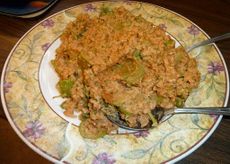
We've dealt with the "main course", and the issue of protein. But there are lots of other foods you'll encounter in your daily life. Now we'll talk about what you should avoid, and what you'll be eating instead, among the lower protein "supporting" foods.
- Chocolate -- All commercially prepared chocolate contains some amount of dairy, whether or not it's listed on the label (this is legal, as mentioned above). So, as a Vegan, you'll be saying No, thanks when the dish of Hershey's kisses comes by.
Vegan alternatives to chocolate: Cocoa powder. As long as it's not mixed with anything, dry cocoa powder is Vegan. Unfortunately, its mouth feel leaves a bit to be desired, in my opinion.
- Egg substitutes -- Eggs are obviously not Vegan. It may come as a surprise, however, that egg substitutes are also not Vegan. They all contain some amount of either milk or egg protein, which is necessary in order to achieve the binding effect which is wanted from an egg substitute. As discussed above, the manufacturers are allowed to leave this off the ingredients list as long as there's less than 5% of it by weight. Consequently, as a Vegan, you'll need to avoid all egg substitutes.
Vegan alternatives to egg substitutes: Just leave them out. Most recipes work without them.
- Pancakes -- Pancakes contain eggs. (Pancakes made without eggs have the texture of kraft paper, and are typically about as thick as a sheet of it.) So, as a Vegan, you must not eat pancakes.
Vegan alternatives to pancakes: Pancakes are normally eaten for breakfast, and there are many other breakfast foods you can eat. (If you can't think of anything else, just leave out the pancakes and drink the syrup; that's a great way to get a burning-rubber start on the day.[10])
- Organic Produce -- Organic vegetables are raised without chemical fertilizers. So what do you think they use instead? Right -- they use poop. And that's not vegan. All organic vegetables are byproducts of animal farming (except in China where they don't use animal poop on the vegetables ... but they still aren't Vegan).
Vegan alternatives to organic produce: Non-organic produce. Fruits and vegetables which are not organic are raised using synthetic fertilizers and pesticides, which are made from petroleum, which is not an animal. So, you can eat them! Just be sure you peel them and cook them thoroughly, to get any insects or insect eggs off them; otherwise, they won't be quite Vegan!
Beverages[edit | edit source]
Some beverages are just fine, but there are some you might expect to be acceptable which are not. We've listed a few here to help you.
- Wine -- When grape juice ferments, the result is a brown, slimy liquid with a mouth feel similar to that of a rotten potato. To clean up the taste and clarify the wine, all vintners add an infusion of fish intestines to the wine as the last step before it's bottled.[11] As usual with ingredients added to improve mouth feel, they are not required to list it on the label. Consequently, commercially made wine is not Vegan, and you, as a Vegan, will not be drinking it.
Alternatives to wine: Laphroaig 20 year old Scotch whiskey -- This is Vegan and it's not bad for your teeth (unlike distilled water). So, you can drink as much as you want! Drink it with every meal -- it's Vegan, so it's all good!
- Lite Beer -- You may have heard that that "lite" beer is made by adding water to beer, but that's false. In fact, "lite" beer is made by infusing the mash with enzymes to speed fermentation and produce a beer-like substance with less sugar than real beer. Unfortunately for Vegans, the enzymes used are of animal origin. So, as a Vegan, you must not drink "lite" beer.
Alternatives to lite beer: Budweiser -- The old (pre-Lite) Bud is Vegan, so go for it! (Some Irish stouts may also be Vegan, but we haven't investigated carefully enough to be sure.)
- Water -- Water that has come from a well, been in a reservoir, or come through pipes invariably contains parasites. These are animals (see above). So, they're not Vegan, and neither is the water which carries them. Consequently, you, as a Vegan, must not drink either tap water or bottled water.
Alternatives to water: Budweiser is Vegan, and can be safely consumed with every meal. (Distilled water is also vegan, but it's really bad for your teeth, so you shouldn't drink it.)
- Espresso -- Black coffee is Vegan! (as long as it's not organic). So, you can drink as much as you want, as long as it's not made with ordinary tap water or bottled water, which would make it non-Vegan.
- Peppermint Tea -- As long as it's not organic, it's Vegan, and it's good stuff! And it helps with gas, so you might want to buy a lot of it (see section on "Protein", above).
Clothing[edit | edit source]
Unfortunately, the situation with textile labeling is very similar to the situation with food. Any fiber which constitutes less than 5% of the weight of the fabric does not need to be listed on the label.[12] Wool greatly improves the handling of other fibers, even when it's only present in small quantities. Consequently, textile manufacturers nearly always blend a small amount of wool with the other fibers they use. As long as it totals less than 5% of the fabric weight, they don't need to mention it on the label.
Therefore, a Vegan must avoid all woven fabrics and all knitted fabrics.
The easiest way to go to get pure Vegan clothing -- aside from the easy option of just not wearing any -- is to go Latex! or to wear a hula skirt Pure latex clothing is pure Vegan -- and it looks good, too!
For shoes, which are notorious for non-Vegan ingredients, your best bet is to cut a pair of sandals from some old truck tires, which are made of petroleum and steel and are totally Vegan.
Medicines, Drugs, Supplements, and Additives[edit | edit source]
Some medications are acceptable, but others are not. In this section we'll discuss a number of them, both Vegan and non-Vegan. We've also included some other items here which didn't fit neatly into any other category.
- Vaccines -- These are not Vegan, and must be avoided. Vaccines, you see, are grown, not synthesized, because they are made from the disease-causing organisms themselves. We're not concerned with the ethics of consuming some flu virus here, but what we are concerned with is the substrate on which the virus is grown.
Flu vaccines are grown on chicken eggs, and are consequently most decidedly not Vegan. So, as a Vegan, you'll just say NO when they come around with a cart loaded with flu shots.
Other vaccines are grown on more exotic substrates, including such things as monkey kidneys and bat brains. What they all have in common, though, is that they are not Vegan. The reason is simple: Disease organisms which attack people don't attack plants, so they can't be grown on a vegetable substrate.
Vegan alternatives to vaccines: You don't need them. You'll be eating so many fresh fruits and vegetables (and beans) that you will find that, once you're a Vegan, you just don't get sick!
- Antibiotics These are also nearly always animal products, and they are always grown in media containing gelatin, which is made from the horns, hoofs, and hide of cows and sheep. So, when you're offered an antibiotic, you'll also just say NO.
Vegan alternatives to antibiotics: See above. Vegans are so loaded up with natural nutrition that they just don't get sick, so you won't be needing any antibiotics!
- Vitamins -- Vitamins are made in machinery, and machinery needs to be lubricated. The lubricant inevitably gets into the pills, so it must be food grade. As with all big companies, when left to their own devices, the manufacturers choose the cheapest food grade lubricant they can find ... and that's lard.
Consequently, all commercially made vitamins use lard in their manufacture, and must be avoided by Vegans.
Vegan alternatives to vitamins: You don't need them. On a Vegan diet, you're positively overloaded with vitamins and minerals from all the vegetables (and beans) you'll be eating.
- Aspirin -- As with vitamins, because of the way they're manufactured, aspirin tablets are not Vegan, and so you must avoid them. The same is true of ibuprofen, Tylenol, Advil, naproxen, and all other pills in this family.
Vegan alternatives to aspirin: Willow bark extract. This is a natural aspirin substitute, which is sold as a tincture, rather than in pill form. It's almost as good as aspirin, and it's totally Vegan!
- Opium -- Pure vegan, all the way! Made from poppies, typically using hand labor, or using machines lubricated with petroleum grease (it's even cheaper than lard, and since the entire opium industry is illegal, it isn't required to use food grade materials everywhere).
- Morphine -- Vegan! If willow bark doesn't do it for you, morphine will -- and it's Vegan (just like opium, only stronger). And it's easily available on the street, so you don't need to bother your doctor for it.
- Mono-sodium glutamate -- The familiar MSG of Chinese restaurant fame is Vegan! And it really helps the flavor of things. Given the
limitednew opportunities of the Vegan diet, you may want to buy a case or two of MSG.
- Crack -- Vegan! Made from pure cocaine, which is a plant product. Consequently, crack is totally OK for you, in your new Vegan lifestyle!
Other Issues[edit | edit source]
While non-Vegans think Veganism is all about food, it's really ever so much more than that. In this section, we'll list a few of the additional little things to watch out for.
- Cigarettes -- No one on Earth knows what's really in a cigarette, as the manufacturers are not required to list the ingredients on the label of anything that isn't considered "food". A typical modern cigarette is known to contain over 300 ingredients, so it's vanishingly unlikely that it's entirely "vegan". So, avoid cigarettes.
Alternatives to cigarettes: Cigars. Unlike a cigarette, with 300 ingredients, a cigar has just one ingredient: Tobacco. It's just a carefully rolled up leaf of tobacco. So, if you want to smoke, smoke cigars. For the safest Vegan smoke, stick with the big fat black ones from Cuba; the skinny "light" cigars which are made in the United States may contain additional ingredients.
- Kissing Humans -- Human mouths contain a whole ecology made up of tiny animals, including, in particular, amoebas, which are among the most advanced (and intelligent) of microorganisms. If you kiss someone on the mouth, you inevitably eat some of these little critters.
So, as a Vegan, you will never kiss another human on the mouth.
Alternatives to kissing humans: Kissing dogs. A dog's saliva contains natural antibiotics, which make its mouth far, far cleaner than a human mouth. Consequently, kissing a dog is considered Vegan, so go for it!
References[edit | edit source]
- ↑ Stranger in a Strange Land, chapter 37, slightly paraphrased. (That's for all you young whippersnappers in the audience who wouldn't have a clue who Valentine Smith was without a reference.)
- ↑ From the Gospel according to Mark, slightly interpolated
- ↑ Ibid
- ↑ The primary author of this page has been a Vegan for many years, so you can trust everything he says about it.
- ↑ ipso dixit
- ↑ See FDA circular number 42745, dated 16 June 2003, "On the preparation and distribution of condiments in commercial packaging intended for retail resale", page 374, final paragraph
- ↑ For those of you who've led a sheltered existence and have never heard the word used literally before, "lard" is pig fat. And, just for completeness, "suet" is beef fat, and "schmaltz" is chicken fat. And just for extra completeness, "cup grease" is nothing at all like what you're probably thinking it is (boy do you have a dirty mind). It's thick glop you put in a grease cup, which was a fitting on old fashioned motors back before they invented greaseless bearings.
- ↑ Yes, really. I'm not making this up. If I can track down the reference I'll add it.
- ↑ It's not what you think it looks like.
- ↑ Chase it with a cup of coffee. Believe me, it works.
- ↑ Common knowledge. (Go find your own link if you want a reference.)
- ↑ I've misplaced my reference on this; when I find it I'll put it here.

